Riga’s house price rises are slowing
 Latvia’s housing market remains very strong, but Riga’s house price rises are now gradually slowing, amidst limited supply.
Latvia’s housing market remains very strong, but Riga’s house price rises are now gradually slowing, amidst limited supply.
According to Arco Real Estate’s figures, apartment prices in Riga rose by 4.89% (1.64% in real terms) to €794 (US$900) per sq. m. during the year to end-Q3 2018, down from 7.22% in Q3 2017. Quarter-on-quarter, house prices rose by just 0.38% (0.63% in real terms) in the latest quarter.
Real estate agent Ober Haus, which tends to deal in high-end city-centre housing, while Arco deals in the estates, shows more muted growth, with the average apartment prices in Riga rising by 3.59% y-o-y in August 2018 to €1,240 (US$1,406) per square metre (sq. m.), a sharp slowdown from last year’s 6.59% growth.
When adjusted for inflation, apartment prices rose by a meagre 0.76%.
Outside Riga, apartment prices continue to rise rapidly.
- In Ogre, one of Latvia’s greenest towns due to its amazing parks and forests, the average apartment price increased about 11% during the year to September 2018 to €594 (US$673) per sq. m.
- In Kauguri, a popular residential area in the western part of Jurmala, the average apartment price rose by 9.1% y-o-y in September 2018, to €564 (US$639) per sq. m.
- In Salaspils, mostly known for its military history, the average apartment price rose by 7.2% y-o-y in September 2018, to €644 (US$730) per sq. m.
- In Jelgava, a hospitable city located on the banks of the River Lielupe, the average apartment price rose by 7.3% during the year to September 2018 to €499 (US$566) per sq. m.
In October 2018, the total number of apartments offered for sale in Riga plunged by 15% from a year earlier, according to Arco Real Estate. Likewise, apartments offered for sale in the country’s largest housing estates were also down 11% over the same period. This reflects insufficient supply, which explains why during the first five months of 2018, apartment transactions in Riga fell by 2.2% to 3,731 units compared to the same period last year, according to Ober Haus, despite strong demand.
The Riga neighborhoods with the highest demand include Purvciems, Kengarags, Imanta, and Plavnieki. Strong demand is also recorded in Ziepniekkalns, Jugla, Iļģuciems and Vecmīlgrāvis.
Why the strong demand? Partly because foreigners get a five-year residence permit in Latvia if they buy residential real estate, under Immigration Law amendments implemented on July 1, 2010. The conditions were then (according to Baltic Legal):
- The transaction should exceed €142,000 (US$ 160,992) in Riga or Jurmala, or €71,000 (US$ 80,496) in other regions;
- Only non-cash funds may be used to buy real estate;
- The buyer must not have any real estate tax arrears in Latvia (and must never have had such arrears);
- Transaction concluded after July 1 2010.
Since the foreign real property buyer visa scheme was launched in July 2010, most foreign buyers have been Russians, looking for properties in Riga and Jurmala. Latvia has one of the lowest house prices in Europe, and foreigners now account for 70% of all property transactions. In recent years, most of the in-demand properties were located in Jurmala, according to the Office of Citizenship and Migration Affairs. Russians have made the most purchases, followed by Ukrainians, Chinese, Kazakhs, and Uzbeks, according to Arco Real Estate’s chairman of the board of directors, Aigars Smits.
In September 2014, Immigration Law amendments increased the threshold for obtaining a residence permit and introduced other conditions and costs, if a foreigner’s real estate was registered in the Land Register after September 1, 2014:
- Minimum transaction value of real estate located anywhere in Latvia must be €250,000 (US$ 283,437).
- The total cadastral value of the property at the time of acquisition should be at least €80,000 (US$ 90,700).
- Payment of a state budget contribution worth 5% of the real estate’s transaction value.
“We expect that in 2018 the average price growth will continue to increase, but will not exceed [2017’s] growth rate which was 6-7% per annum,” said BALSTS CEO Aigars Zarins.
In the third quarter of 2018, the economy grew by 4.8% from the same period last year, slightly down from the previous quarter’s 5.3% y-o-y growth, according to the Central Statistical Bureau of Latvia (CSB). The economy is projected to grow by 4.1% this year, from annual expansions 4.6% in 2017, 2.2% in 2016, 3% in 2015, 1.9% in 2014, 2.4% in 2013, and 4% in 2012, according to the European Commission.
Latvia’s housing boom and bust
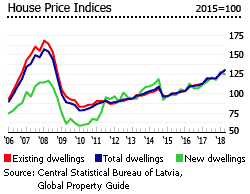
Latvia had one of the world’s biggest housing market crashes after 2007. The crisis began when Latvia’s economy expanded by an average of 8.5% from 2000 to 2007, during which period property prices rose by almost 700%. Inflation rose from 2.5% between 1999 and 2003, to over 10% in 2007. By the second half of 2007, the housing bubble had burst. House prices plummeted.
In 2008, Latvia was able to secure a €7.5 billion (US$ 8.5 billion) standby loan from a group led by the European Union (EU) and the International Monetary Fund (IMF), coupled with rigid austerity measures. The bailout prevented total economic collapse. More than €3.3 billion (US$ 3.7 billion) of the funds were used to pay public sector wages and maintain essential services, but nevertheless, austerity was a condition of the bailout.
Nevertheless, the economy shrank by about 25% from the start of the global crisis in 2008 to end-2010, making it the deepest depression recorded worldwide. Unemployment surged from 6.1% in 2007 to 19.5% in 2010. The country’s fiscal deficit shot up, capital left the country, exports fell, and domestic demand collapsed.
- In 2007, apartment prices dropped by 5.01% (-16.71% in real terms) from a year earlier.
- In 2008, apartment prices plummeted by 30.47% (-37.11% in real terms) y-o-y
- In 2009, property prices plunged by another 42.02% (-41.34% in real terms)
Then in 2010, the housing market started to recover, with house prices rising by 5.05% (2.49% in real terms), and then rising another 5.79% in 2011 (1.65% in real terms). In 2011 Latvia achieved GDP growth of 5.5%, and growth of 5.6% in 2012.
In 2012 house prices increased by only 2.06% (0.48% in real terms), partly due to tighter credit policies. In 2013, house prices rose by 4.15% (4.57% in real terms).
In 2014 house price rises slowed to 2.23% (2.03% in real terms), followed by meagre growth of 0.38% (0.04% in real terms) in 2015. The slowdown in prices was due to the amendments in the residence permit program, implemented in September 2014, which mainly affected new apartments built for foreigner buyers.
The housing market regained its momentum in 2016, thanks to strong economic growth, coupled with limited supply. House prices rose by 8.14% (5.85% in real terms) in 2016 and by another 6.12% (3.86% in real terms) in 2017.
Demand remains robust, but supply insufficient
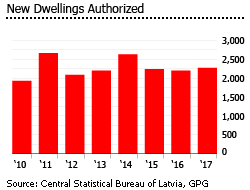
During the first five months of 2018, apartment transactions in Riga fell by 2.2% to 3,731 units compared to the same period last year, according to Ober Haus. This was supported by BALSTS, with its latest figures showing that the number of transactions for standard-type apartments dropped 2.38% y-o-y in Q1 2018, due to limited supply.
“The decrease is due to the insufficient supply of standard-type apartments, as a result of which transaction activity is gradually moving towards the new project segment,” said BALSTS.
Dwelling completions in Latvia increased slightly in 2017. In fact in Riga, a total of 1,458 apartments were constructed in 2017, up 16% from a year earlier, according to Ober Haus.
Despite this, the actual number of apartments offered for sale in Riga remains down by 15% in October 2018 from a year earlier, according to Arco Real Estate. Likewise, apartments offered for sale in the country’s largest housing estates were also down 11% over the same period.
Before independence, more than 10,000 apartments were completed annually. After independence the number of dwelling completions dropped to less than 1,000 units annually between 2000 and 2003.
It was only in 2004 that housing construction began to pick up and completions peaked at 9,319 units in 2007. Owner-occupancy rose dramatically, from 21% in 1990 to 87% in 2006.
However the sudden increase in supply flooded the market, pushing prices down. Units started in 2006 and 2007 are still being completed, and completions still remain far below the peak.
Low interest rates
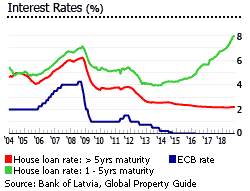
The ECB key rate remained at its all-time low of zero in October 2018, unchanged since March 2016.
Housing mortgage costs for new loans:
- Floating rate and up to 1 year IRF: 2.32% in September 2018, slightly down from 2.34% a year earlier
- 1-5 years IRF: 8.61% in September 2018, up from 5.79% a year earlier
- 5-10 years IRF: 10.82% in August 2018, down from 11.43% a year earlier
- Over 10 years IRF: 5.49% in August 2018, up from 4.87% a year earlier
For outstanding loans, in September 2018:
- Housing loans with maturity of up to 1 year: 2.59%, down from 3.44% a year earlier
- Housing loans with maturity over 1 year and up to 5 years: 7.97%, up from 6.6% a year earlier
- Housing loans with maturity over 5 years: 2.19%, almost unchanged from 2.17% a year ago
Mortgage market continues to shrink, despite introduction of a state support programme
It was not until 2008 that mortgage market growth ground to a halt; since then, the country’s share of total mortgage debt to GDP has shrunk from 36.6% in 2010 to 16.2% of GDP in 2017.
Even today, the value of outstanding housing loans continues to decline as most foreign homebuyers typically prefer to pay in cash. In September 2018, the total value of housing loans outstanding fell by 6.4% to about €4.09 billion (US$4.63 billion) from the same period last year, according to the Bank of Latvia.
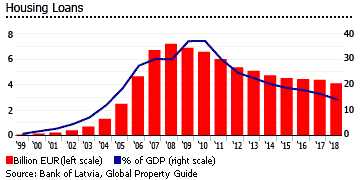
The decline has continued despite the introduction of the state-guaranteed Mortgage Loan Programme in 2015, under which the Latvian Development Finance Institution (ALTUM) provides guarantees for mortgage loans granted by commercial banks to families with children. From the program’s inception in January 2015 to June 2018, state guarantees already total €61 million (US$69.2 million), benefitting about 8,708 families. About 67% of the guarantees have been granted in Riga and Pieriga, 14% in Vidzeme, 9% in Kurzeme, 7% in Zemgale, and 3% in Latgale.
Since March 2018, the Mortgage Loan Programme has been expanded to cater to young professionals, in addition to families with children.
Housing loans with a maturity of over 5 years account for 97.3% of all loans in September 2018. Loans with maturity of up to 1 year and those with maturity of 1-5 years represented 1.6% and 1.1%, respectively.
Rental yields are moderate; rents rising again
Recent research conducted by the Global Property Guide showed that apartments located in Riga city can earn yields ranging from 3.8% to 5.7%. Bigger apartments of around 120 sq. m. have lower yields as compared to smaller units.
Surprisingly in 2016, rents for upper-class apartments in downtown Riga dropped 15% to 20%, due to declining demand for rental apartments, according to real estate firm Latio. However the residential rental market bounced back again in 2017, with average rents rising by around 5%, according to Ober Haus.
The highest apartment rents can be found in the city centre, Old Town. Rents for two-room upper-storey apartments range from €650 (US$737) to €800 (US$907) per month, while three-room apartments can be rented from €700 (US$794) to €1,500 (US$1,700) per month, according to Ober Haus.
In popular residential districts, monthly rents for one-room apartments range from €200 (US$227) to €300 (US$340). Two-room apartments have monthly rents ranging from €250 (US$283) to €400 (US$454) while three-room apartments are rented for €350 (US$397) to €550 (US$624).
“The highest demand for rental apartments is observed in housing estates closer to center of Riga - Purvciems, Pļavnieki, Imanta and Āgenskalns. Āgenskalns, in particular, due to its central position, and the quantity of new development, has become increasingly more expensive in recent years,” said BALSTS.
Strong economic growth
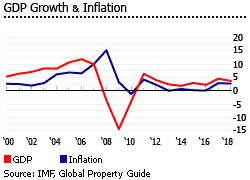
On January 1, 2014, Latvia adopted the euro. Its adoption is a recognition of economic success, especially in taming inflation and limiting the budget deficit to just 0.6% of GDP in 2017, according to the European Commission . The deficit is expected at around 0.8% this year and at 1% in 2019.
In the third quarter of 2018, the economy grew by 4.8% from the same period last year, slightly down from the previous quarter’s 5.3% y-o-y growth, according to a flash estimate released by the Central Statistical Bureau of Latvia (CSB). The strong growth was fuelled by booming construction sector, coupled with robust retail trade and industrial sectors.
The economy is projected to grow by 4.1% this year, from annual expansions 4.6% in 2017, 2.2% in 2016, 3% in 2015, 1.9% in 2014, 2.4% in 2013, and 4% in 2012, according to the European Commission .
Latvia’s public debt was projected to fall to 37.1% of GDP in 2018 and to 35.5% of GDP in 2019, from 40% in 2017, according to the European Commission.
In Q2 2018, nationwide unemployment stood at 7.7%, down from 8.2% in the previous quarter and 8.9% a year earlier, according to the CSB. The country’s jobless rate averaged 17.1% from 2009 to 2012 and 10.2% from 2013 to 2017.
Inflation was 3.2% in October 2018, up from 2.8% a year earlier, according to the CSB. In 2017, overall inflation surged to 2.9%, from just 0.1% in 2016, according to the International Monetary Fund (IMF).
Latvia has officially become the 35th member of the prestigious OECD in July 2016.
Latvia faces uncertain political landscape after pro-Russian party wins general election
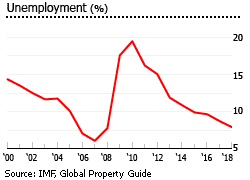
In February 2016 PM Kučinskis took office after former PM Laimdota Straujuma resigned in December 2015, due to the infighting within the ruling coalition. PM Kučinskis’ government has focused on strengthening the economy and dealing with growing concerns about neighboring Russia.
However, the future of his government is now uncertain after the ruling coalition lost its majority during the October 2018 general election, with the pro-Russian Harmony party emerging as the largest bloc in parliament, winning about 20% of the votes. Right-wing populist parties, KPV LV and the New Conservative Party, also performed well, winning 14.1% and 13.6% of total votes, respectively.
PM Kučinskis’ governing coalition only won more than 27% of votes (Union of Greens and Farmers with 9.9%; the National Alliance with 11%; and the Unity party with 6.7%). Their support was hit by public dissatisfaction over the fight against money-laundering and corruption.
Harmony has recently said that it wants Latvia to stay in the EU and NATO, but also to have closer economic ties with Russia. It is now under coalition talks with the right-wing populist parties. During the previous election, Harmony also won the most seats in parliament but was blocked from power when other parties refused to work with it due to its ties with Russia.
Latvia’s relations with Moscow deteriorated following Russia’s annexation of Crimea in 2014. Russia’s aggression prompted Estonia, Lithuania, and Latvia to seek NATO troop deployments in their nations. Article 5 of NATO’s charter states that a military attack on one member state is an attack on all of them.
However recently, relations between Russia and Latvia improved after an agreement was signed in November 2017 on easing the procedures on mutual journeys of border residents of the two countries; and the plan of cooperation between the two countries for 2018-2019. The agreement also provides for closer cooperation in such areas as security, cooperation in international organizations, and the Baltic Sea region, among others, according to Andrejs Pildegovics, Latvia’s State Secretary of the Ministry of Foreign Affairs.